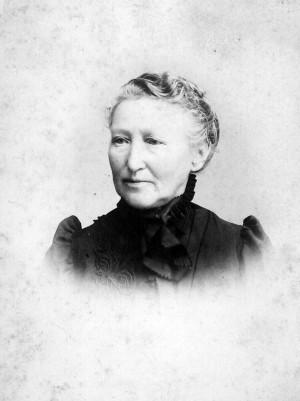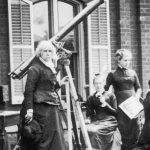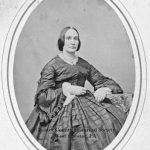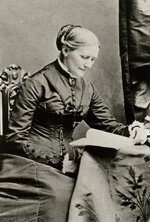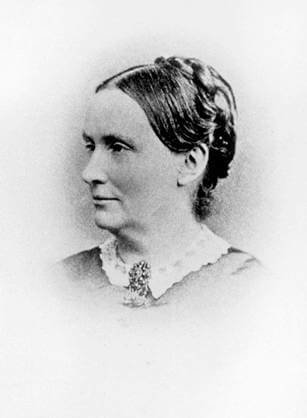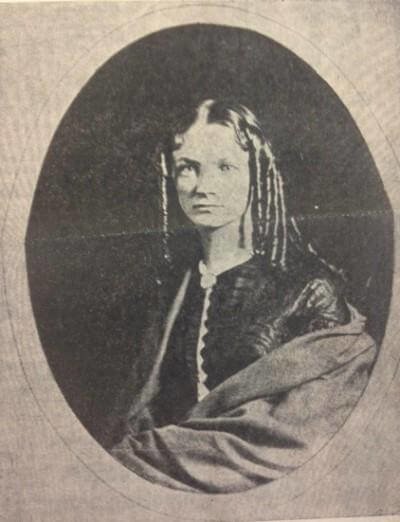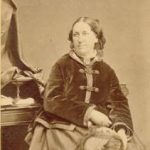Pioneer Scientist and Author
Mary Treat was a naturalist from New Jersey and a major contributor to many scientific developments of the nineteenth century. She is most well known for her extensive work in botany and entomology. Four species of plants and insects were named after her. She also corresponded with Charles Darwin. Treat was a pioneer in several areas of natural sciences.
Image: Mary Treat in 1904
Mary Lua Adelia Davis was born September 7, 1830 in Trumansburg, New York. Her parents were Isaac Davis, a Methodist minister, and Eliza (English) Davis and she had one sister, Nellie. In 1839 her family moved to Ohio where she attended public school and, for a short while, a private girls’ academy.
In 1863 Mary Davis married Dr. Joseph Burrell Treat, a medical doctor who also wrote and lectured on various subjects such as astronomy, physics, women’s rights, atheism, abolitionism and Transcendentalism. For a while they lived in Iowa, and then in 1869, the Treats moved to Vineland, New Jersey to join the intellectual community recently established by Charles Landis.
Career in Science
Mary Treat became interested in science, particularly entomology (the study of insects). Her early scientific work detailed life histories, feeding behavior, and ways of controlling many insect pests. She frequently moved around for her scientific study. Her first scientific article was a note published in The American Entomologist when she was 39 years old.
After separating from her husband in 1874, Treat supported herself by publishing science articles for periodicals such as Harper’s Magazine (1850-) and Queen, a British publication established by Samuel Beeton in 1861. She also published articles in The American Naturalist (1867-), The Journal of the New York Entomological Society (1893-1922) and in popular magazines such as Harper’s New Monthly Magazine (1850-1899) and Lippincott’s Monthly Magazine (1868-1915).
Mary Treat was one of four American women botanists publishing before 1880 and was the most well-known and prolific of this group. Over the next 28 years she wrote 76 scientific and popular articles, as well as five books. Her book Injurious Insects of the Farm and Field (1882) was reprinted five times. In order to feel close to her readers, Treat wrote in a familiar voice, vastly different from the conceited air of the so-called (male) experts.
She carefully crafted a public version of herself within contemporary notions of acceptable feminine behavior. In speaking collectively (Our Familiar Birds, for example) she minimized the distance between her and her audience, in the process differentiating her kind of science from the masculine expert equivalent.
Treat wrote letters to engage in botanical and entomological discourse with her fellow scientists, all males, of course. While she conducted research for her own studies, she also took requests from others, who occasionally asked her to collect plants and insects to aid in their studies, including such naturalists as Charles V. Riley, Sir Joseph Hooker and Asa Gray.
Charles Darwin
It was the eminent Harvard botanist Asa Gray who introduced her to the legendary English evolutionist Charles Darwin. Treat and Darwin exchanged fifteen letters over five years (1871-1876). Treat and Darwin’s recorded correspondence took place when Darwin was researching and publishing about carnivorous plants. Their first recorded correspondence is from December 20, 1871 in which Treat describes the fly-catching activities of Drosera, commonly known as the sundews.
Investigations of these plants are the predominant theme in their correspondence, and Treat does not hold back when critiquing Darwin’s hypotheses. He found Treat’s work helpful, and he requested her to supply him more information about carnivorous plants. Darwin acknowledged her contribution in his book, Insectivorous Plants (1875): “Mrs. Treat of New Jersey has been more successful than any other observer.”
Darwin praised her experiments on controlling the sexes of butterflies and wrote that they were “by far the best, as far as known to me, which have ever been made.” Her descriptions of behavior of insects helped taxonomists in classifying new species. Treat discovered a new species of an orange aphid, an Ichneumonid fly, two spiders and an ant, named Aphanogaster treatiae in her honor.
Prolific Author and Researcher
In her own backyard in Vineland, in short trips to the pinelands and while spending her winters in Florida, she found enough material to publish extensively as a botanist, entomologist and ornithologist. She used her home and garden in Vineland as a living laboratory. She often wrote of her insect menagerie, an area in her garden where she spent long periods observing ants and spiders actively encouraging them to set up home by creating nooks and crannies for them to live in.
Although Treat mainly worked in her garden and parlor she also made regular forays in a ten mile radius around her home in Vineland and began spending winters in Florida. She was so fond of studying spiders she constructed temporary cases in large specimen jars, while she continued her observations:
I capture spiders for investigation by cutting out the nests with a sharp trowel or large knife, and have ready some glass candy jars from 12 to 14 inches in height, in which I carefully place them. I then fill in with earth all around… and cover the surface with moss, introducing some pretty little growing plants, so that my nervous lady friends may admire the plants without being shocked with the knowledge that each of these jars is the home of a spider.
In Home Studies in Nature (1885), she stated that, “The smallest area around the well-chosen home will furnish material to satisfy all thirst of knowledge through the longest life.” She also put forward several theories, which have since been proven to be correct, one of these being that nectar secreted by sarracenia plants (a form of carnivorous plant shaped like a pitcher) contains an intoxicant that affects the ability of flies to move.
Home Studies in Nature illustrates how Treat tempered what might be considered a masculine interest in natural science by using language and imagery which identified her work as appropriately feminine. This is an excerpt from Chapter V, Spiders and Wasps:
I sometimes think the more I limit myself to a small area, the more novelties and discoveries I make in natural history. My observations for the past four summers have been almost wholly confined to an acre of ground in the heart of a noisy town. A bit of natural woodland occupies about a quarter of the acre, and here I have made several discoveries new to science.
The most interesting creatures that have rewarded me in my search are two species of large burrowing spiders that had heretofore escaped the attention of naturalists. These spiders build beautiful, complicated structures above their burrows, with which they take as much pains as most birds do in building their nests.
The Rev. Dr. [Henry] McCook has named one of these spiders Tarantula tigrina, or tiger spider, from the fact that the legs have annular stripes of gray and black, like a tiger’s. This species digs, a tube in the earth six or seven inches in depth and uniformly straight. But its skill and wisdom are displayed in erecting the upper part of its domicile, which is evidently for concealment…
I had repeatedly tried to see one go on with its building, but the light of the lamp or my near proximity seemed to disturb it. At last I had the satisfaction to see a fine large female go on with her work, undisturbed by the light or my presence. She first spins a canopy of web over the funnel, leaving a place of exit on one side.
She next comes out and steps carefully over the canopy, as if to see whether it is strong and secure. Seemingly satisfied that it is all right, she steps down, just letting her fore-feet touch the edge of the web, while with her hind-legs she feels, examines, and handles various things which she rejects. Finally she selects a dry oak-leaf about two inches broad and three in length, and lays it over the canopy, and proceeds to fasten it down all around except at the entrance.
After the leaf is made secure she reaches up and pulls down blades of grass, and lays them over the leaf, and fastens them down with web so dexterously that it cannot be seen except with the closest scrutiny. This makes a strong roof over her domicile…
Late Years
On one of her trips to Florida, Treat discovered a new species of amaryllis along the St. John’s River. It was named Zephyranthus treatiae in her honor. On another trip she found an aquatic plant with a yellow flower (Nymphaea lutea) and sent the specimen to Asa Gray. This plant had been previously identified by Lutren and painted by John James Audubon, but then it was lost before it could be described scientifically.
Treat spent many years creating a wide range of impressive work. She traveled to many different places and documented many species of both plants and animals. From her earnings she was able to buy her own house in Vineland and live comfortably after she retired.
In 1913, the Public Ledger daily newspaper in Philadelphia published a profile of Treat, calling her the “World’s Most Famous and Industrious Woman Naturalist,” while also stating that few people in Vineland were aware of her renown. Before her passing, she left much of her correspondence and writings with the Vineland Historical and Antiquarian Society.
In 1916 Mary Treat moved to Pembroke, New York State to live with her sister. She died there on April 11, 1923 due to complications from a fall, at age 92. She was buried in Vineland, New Jersey, where she spent much of her time living and conducting her beloved research.
Historian and scientist Harry B. Weiss wrote in a 1955 article on Treat’s life in the New Jersey Historical Society magazine:
Although neglected heretofore by natural history biographers, Mrs. Treat deserves a place in the history of New Jersey’s natural history as its first capable woman naturalist.
SOURCES
Wikipedia: Mary Treat
The Public and Private Face of Mary Treat
Women in Natural History: Mary Treat and her Traps – PDF
Distinguished Women in Past and Present: Mary Davis Treat
